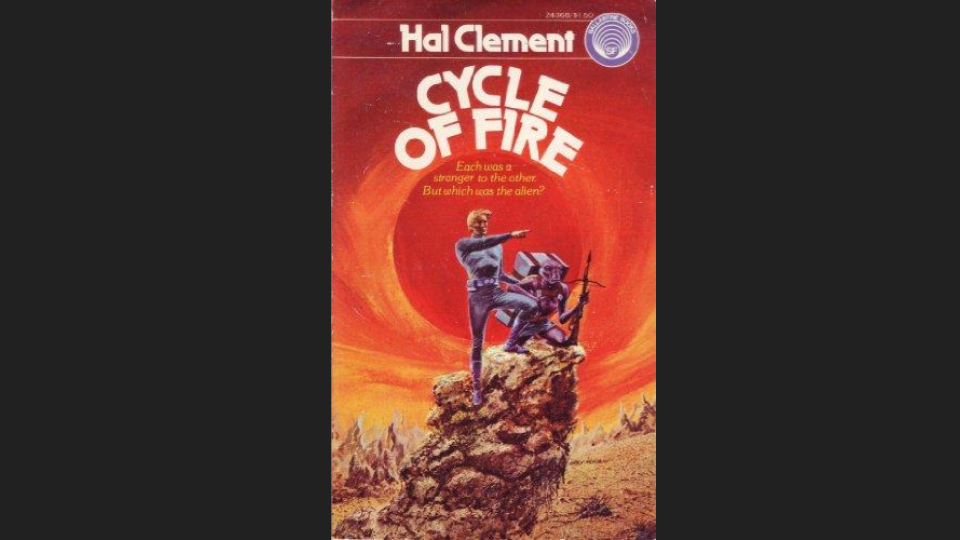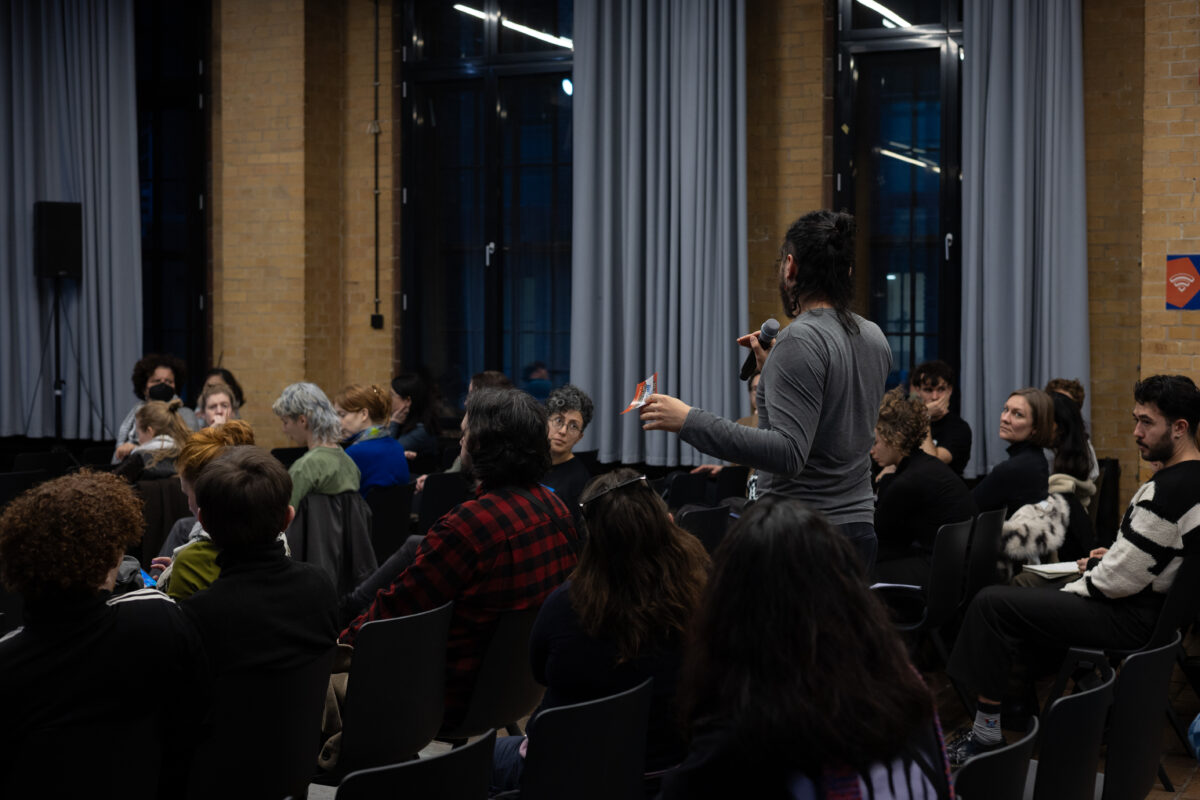Reading Cycle of Fire by Hal Clement (1957), which I only knew of because I found in a “Zu Verschenken” box on a Neukölln street, has made me more aware of the political power that hard science fiction harbors. Cycle of Fire is not an abstract futuristic fantasy novel, but a concrete speculative anthropological, geological and biological exercise put into words through a field research journey.
Clement uses the shipwrecked narrative formula to introduce the two main characters, Nil Krüger and Dar Lang Ahn. Nil is a young human and part of an exploratory mission from Earth who ends up crashing in Dar’s planet Abyormen. Dar is a non-human native from this world, who also encounters himself lost as he undergoes a rite of passage, in which young individuals like Dar are expected to travel alone across the planet to gain experience and survive the extreme environmental conditions caused by Abyormen’s dual sun. This extreme climate sets the stage for the main political conflict, while the reader is gradually introduced to the intricate scientific details of Abyormen’s environment and unique ecosystem.
One of the central questions that Clement explores is the interspecies relationship between Earth humans and Abyormen locals. One could argue that the way he initially portrays both kinds of creatures mirrors the classic identity dichotomy between European and native, as Nil tries to technologise Abyormen society with Earth knowledge. However, as the story develops, Nil and Dar’s relationship solidifies, making Nil aware of his intrusive mindset. This is a relevant point as in general, the novel doesn’t have a strong action plot, as most of it is just descriptive scientific documentation, but one of the elements that kept me engaged in terms of character development is the caring and fraternal relationship between both protagonists.
Dar is generally described as a kind of bipedal reptilian with humanoid features, while Nils is a representation of the American white, young, male archetype which characterises every Hollywood superhero story. However, Dar is an incredibly knowledgeable character with a great intellectual capacity and philosophical depth, which gradually affects Nils in his way of perceiving the Abyormen’s natives, making him realise that this “otherness” he was projecting on Dar, was in fact, not so clear (that’s why the following sentence “each was a stranger to each other, but which was the alien?” appears on the front cover of the book). From the beginning, both characters rely on each other for survival and the bigger political question behind it is exactly that one, the symbiotic relationship between species is imperative for the development of life in all forms. This is also treated in a biological sense, as Clement goes through a very detailed explanation of how bacteria helps the natives adapt to their extreme climate environment (as Abyormen has two kinds of Abyromenites, the “hot season” ones and the “cold season” ones, which Dar is part of and constitutes also, a big part of the plot).
I would like to mention Donna Haraway’s work here, in her publication When Species Meet she talks about ethical responsibilities regarding human to-non-human interactions. She is concerned with how we understand and treat other species, particularly when they are framed as “other” or as objects of study or exploitation. In the novel, the humans’ arrival on Abyormen presents an encounter between species with vastly different ways of life and forms of biological understanding. Regarding Haraway, the ethical considerations surrounding interspecies contact become central. Humans, with their technologically advanced but ecologically naive mindset, must navigate the delicate balance of interacting with the native species and ecosystems without exploiting or disrupting them, which is something Nil finally gets to grasp.
From an anti-colonial point of view, this knowledge dichotomy between Nils and Dar can also be interpreted as differences between the Western ideal of self-importance through technological superiority and indigenous symbiosis and ecological knowledge (like in the plot of Avatar). But this also leads us to the conclusion that technological development is a natural process of evolution itself, as seen in the book, and it can’t be avoided. So the interconnectedness between organisms, technology, and the environment is what creates life, (in this case Earthlings, cold Abyormenites and warm Abyormenites) where boundaries between species, technologies, and organisms become diluted in this network of co-constitutiveness (just how historical materialism shows us how we live in a dialectical relationship around us).
However, the fact that Abyormen is constantly under extreme geological and environmental conditions is not unintentional, considering that Clement himself was a chemist and astronomer therefore acutely aware of the impact of human industrial development on Earth during the first half of the 20th century. Abyormen’s ecosystem can also be seen as a critique of colonial exploitation of the environment, where the balance of ecosystems is interfered to serve economic interests. The survival of the native species, like Dar, and their ability to adapt, contrasts with the destructive and (in the case of the initial Nil Krüger and his kind), shortsighted actions of colonizing forces, reinforcing the idea that knowledge comes from understanding the aforementioned symbiotic environmental relationships with the land. By Nil identifying with the Abyormen and developing his love and respect for Dar, he manages to resolve the plot conflict by rejecting any kind of species-based hierarchical differences, allowing to establish a collective and mutual dependency relationship between Earthlings and Abyormenites.
As a final point, I want to mention the role of the Teachers who are the ruling institution in Abyormen and maintain a powerful position as they regulate labour and knowledge. This is also something Nil witnesses and tries to fight against (while we have no information about Nil’s societal organisation forms other than scientific researchers working in teams). These Teachers are described as looking the same as Dar (all Abyormen’s population looks the same) but bigger and taller, which makes Nil argue against their policies of gatekeeping critical survival knowledge and manipulating their society’s ideology by exploiting them through labour and reproduction (he believes that they grow bigger at the cost of sacrificing Abyormenites like Dar). However, the story provides another understanding of their role, which leaves it to the reader to freely interpret their meaning. This aspect of the book can offer further analytical development regarding the sociology of Abyromen which would lead to a debate about the creation of political systems in SF, and their role in learning how to overthrow current systems of oppression and exploitation.
Although Cycle of Fire is not a revolutionary novel, it does serve as a great exploration of interspecies relationships and the consequences of technologised colonisation processes. Through the dynamic between Nil and Dar, Clement invites readers to reconsider hierarchical relationships between species, technology and culture. The gradual transformation of Nil Krüger’s relationship with Dar tells us that co-evolution and co-dependence are imperative processes to survival and collective liberation.




